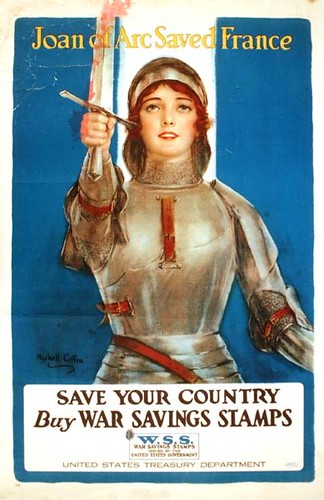
http://www.flickr.com/photos/mfspeccoll/4903407438/in/set-72157624742434...
This poster of Joan of Arc aptly demonstrates Pearl James' argument that "War poster reflect the period's confusion of traditions and modernity. In war posters new national identities coalesce around nostalgic visions from the past." (2) The maid of Orleans is legendary as much for her martyrdom as for her martial prowess, and invoking her image folds these two ideals into one, suggesting an understanding of total war which must include both physical courage and spiritual sacrifice. Traditionally, Joan's death has been understood to be founded on her faith in both her own salvation and retribution against her English persecutors. The mythic element of the story, the symbolic association between Joan's death and French military success, is vividly dramatized (and exaggerated) in Dreyer's famous film The Passion of Joan of Arc. Though the film post-dates the poster, it demonstrates the power that Joan held as a symbol not only of martial heroism but of belief in national virtue, the conviction that one's country is fighting for what is right and must therefore succeed.
On the surface, she seems a natural propagandistic emblem for a WWI poster, but there are complicating elements. Although she is decked out with sword and armor, Joan's femininity makes her a dubious stand-in for the reality of national military efficacy, given that women did not participate in combat. The actual message on the poster "Joan of Arc Saved France. Save Your Country. Buy War Savings Stamps" again must draw our focus away from armed conflict and toward the war front. But Joan, by her nature as a saint and martyr, is problematic as an everyman figure. Linking her military victories and death to war savings stamps drags mythic heroism down into the realm of the mundane. On the home front, it reflects Roland's discoveries on the battlefield in Testament of Youth: that war is not heroic after all but ugly and banal. In Roland's opinion, this is a function of modernity; there were heroic deeds, there were mythic figures like Joan of Arc, but he believes they no longer exist in his age. On the field, war is fought by nameless corpses rather than legendary heroes. Elsewhere, war is fought with stamp-buying rather than martyrdom and divine justice. In the midst of a war defined by future shock and the participation of an endire society, the summoning up of a mythologized individual from the past brings with it inevitable tensions.

Comments
Elizabeth Hartney
Mon, 02/04/2013 - 22:06
Permalink
I think it's interesting that
I think it's interesting that they would choose a very famous female heroine for a war poster. It's perhaps suggesting that all of the men who had not yet enlisted were cowardly because saving a country is so simple that a woman could do it. The fact that they over-simplified the story by just saying that she "saved France" suggests they were reminding the viewer that small actions have big consequences and so something as insignificant as buying a stamp could save the war. I don't think they are glorifying Joan but instead belittling her story by suggesting that modern day soldiers/housewives have the ability to do what she did with somewhat easy actions.
Rebekah Chung
Mon, 02/04/2013 - 22:30
Permalink
This poster really seems to
This poster really seems to sum up one of the greatest impacts of World War I on our view of war today, as a culture and as a nation. The religious symbolism, associated with war, indicates a naivete about the realities of violence and death as easily justifiable in a clear-cut, black and white manner. We are on the side of God, it says, therefore we must necessarily prevail. If World War I taught us anything, however, it is that war is the last place a person might expect to find God. The horrors of it may drive men to cry out to him, but those horrors are also pointedly godless. Where Christianity asserts the love of God for the individual, the war says that all corpses in the end, headed for the same fate.